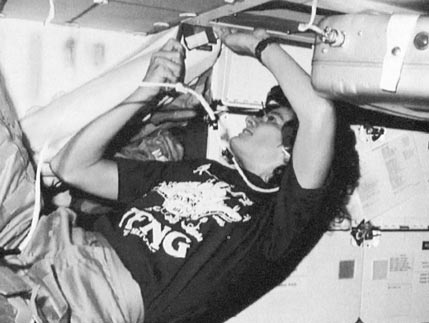Ad Astra per Aspera
By Kathryn Sullivan
A former astronaut discusses three recent books about the challenges faced by women who have reached for the moon
A former astronaut discusses three recent books about the challenges faced by women who have reached for the moon

DOI: 10.1511/2004.45.0
Promised the Moon: The Untold Story of the First Women in the Space Race. Stephanie Nolen. xii + 356 pp. Four Walls Eight Windows, first published in Canada by Penguin Books in 2002. $22.95.
The Mercury 13: The Untold Story of Thirteen American Women and the Dream of Space Flight. Martha Ackmann. Foreword by Lynn Sher. xiv + 239 pp. Random House, 2003. $24.95.
Almost Heaven: The Story of Women in Space. Bettyann Holtzmann Kevles. xiv + 274 pp. Basic Books, 2003. $25.95.
In 1978, a few weeks before we were slated to report to the Johnson Space Center to officially sign on as astronauts, I joined up with classmate Sally Ride in Palo Alto to catch some baseball and hang around the Stanford campus. Sally shared with me an intriguing letter she had received from a corporate pilot based in San Francisco. The writer, Jan Dietrich, said she had been a candidate for the astronaut program back in the early 1960s, and she invited Sally to her home for a visit.
Sally and I were both among the millions of young people entranced by the space program from its inception, and I thought I knew its history pretty well: There had never been any women in the program, nor, as far as I knew, had women even been considered for it. Curious, if somewhat baffled, we made arrangements to meet Ms. Dietrich and hear her story. This bit of tea and conversation in San Francisco was my first glimpse into the world of 13 remarkable women once known as the "FLATs" ("Fellow Lady Astronaut Trainees") and more recently dubbed "the Mercury 13."

In the mid-1990s their story resurfaced, and the telling of it gained fresh vigor, when space shuttle pilot Eileen Collins was introduced to the group in Oklahoma. Many of them were Colonel Collins's special guests at her first launch in 1995 and again in 1999 when she became the first American woman to command a space mission. In the years since, the tale of these tenacious women and their fight to fly in space has been told in plays, a photo exhibit, a flurry of newspaper and magazine articles, and, most recently, the three excellent books reviewed here.
Promised the Moon, by Stephanie Nolen, and The Mercury 13, by Martha Ackmann, focus on the U.S. space program and the story of the FLATs during the pivotal early period from 1959 to 1962. Drawing on numerous personal interviews as well as historical sources, Nolen and Ackmann bring to life each of these 13 women of passion, strength and ingenuity. All but one of them began in very ordinary circumstances. Despite formidable obstacles, each forged a path into aviation and dreamed of a role in spaceflight. Their stories serve as a useful lens through which to look back at the social and political fabric of America during the Cold War era of the early 1960s, on the cusp of the profound changes that were about to sweep through American society. Both Ackmann and Nolen use this lens very effectively, examining not only gender roles and questions of social equity but also the backdrop of the era's political, social policy and national security environments. That the mores and attitudes of those times seem today an odd mix of the comically quaint and the reprehensible is a sign of some progress.
The key dramatic thread in this story is a central question: Did NASA formally recruit and train the FLATs in secret, only to abandon them at the 11th hour, or did eager hopefulness cause the women to read too much into what was perhaps no more than a pet medical research project of Randy Lovelace, who chaired NASA's Life Sciences Committee and whose Lovelace Foundation served as the de facto medical clinic for NASA? Ackmann and Nolen each probe the matter incisively, doing their own investigative reporting. They examine the complex mix of events, personalities, social factors and politics that determined the course of the early U.S. space program and thus the fate of the dreams of the FLATs. Each reaches the conclusion I have long presumed to be true, that NASA never seriously considered giving the Mercury 13 astronaut status. That some of them (especially Jerrie Cobb) believed and fervently hoped otherwise is attributable to many factors, including their own optimism, Randy Lovelace's encouraging if somewhat ambiguous language in his letters to them and a naiveté that mistook civility for commitment. It wasn't a lack of qualifications that kept them out of the running; prevailing social views and competing political objectives did.
Another central theme is the intense rivalry between Jacqueline Cochran and Jerrie Cobb. Rendered vividly by both Ackmann and Nolen, this subplot illustrates clearly that the competitive drive for power and status can be as strong and vicious in women as in men. Ackmann's account of Cochran's correspondence with key government officials and her intricate dance with Cobb is especially fascinating. Each book also contains a wealth of interesting details about notable figures from this era. Two of my favorites: I grew up reading about women who flew in the Powder Puff Derby, a transcontinental air race for women only, but who knew Will Rogers gave that great competition its name? And aboard both NASA research aircraft and the shuttle, I wore a pressure suit manufactured by the David Clark Company, but I never knew that Clark began his career as a lingerie maker!
It's no small feat to synthesize voluminous interviews and historical sources into a tale that's a delight to read. Both Nolen and Ackmann succeed quite admirably, weaving narratives that are engaging and compelling.

In Almost Heaven, Bettyann Holtzmann Kevles tackles the larger story of women in space, encompassing both the U.S. and Russian programs from their inception until the present day. Like Nolen and Ackmann, Kevles draws on a very robust set of personal interviews and the published historical record to create a richly informative, highly readable account. The history of the FLATs is condensed to 13 pages here (Kevles reaches the same conclusion as Nolen and Ackmann regarding the controversy). We meet their Soviet contemporaries—Valentina Tereshkova and Valentina Ponomareva—and get a fascinating look at the sociopolitical backdrop for the early Soviet space program. Almost Heaven more than matches Jim Oberg's Red Star in Orbit when it comes to providing fascinating details about that program. To offer just one example, the early Vostok cosmonauts did not land inside the capsule; rather, they ejected for a separate parachute landing (technically disqualifying themselves for the international flight records they claimed, which require that the record-setting pilot land with the craft).
Throughout the four-decade span covered in Almost Heaven, Kevles provides a nuanced look at how national history, culture and ideology have shaped the designs of the space programs in the two nations, discussing (among other things) the role of the individual versus that of the central control authority. Events and personalities have more political and budgetary context here than in the Nolen and Ackmann books, and a wider variety of relevant officials and commentators provide perspective. This greater scope, which I found very appealing, is achieved without sacrificing rich insights about the individual women being portrayed.
The text of Almost Heaven is carefully footnoted. Unfortunately, and incongruously, it is marred by a number of factual errors. Some are fairly minor, although to me they were glaring: for example, describing roads around the Johnson Space Center as having been unpaved in 1978, citing five flights rather than four in the shuttle test phase and mistaking the T-38 aircraft for the KC-135 aircraft used in parabolic zero-gravity flights. However, in at least one instance, errors shaped the dramatic thrust of the narrative: In framing the selection of the first American woman to fly in space, Kevles says that eight women were vying for the nod, and she asserts that the selection might have boiled down to Ride and Judith Resnik because they were the two youngest. There were indeed eight women in the astronaut corps at this time (six from the class of 1978 and two from the class of 1980), but it is a well-known fact that only women from the class of 1978 were contenders for this assignment. On the second point, I have no idea what actually determined the choice (it's a deliberately secretive process), but Ride and I were "the two youngest," not Ride and Resnik.
Kevles gives the reader a good sense of the tenor of the moment and gets the dramatic arc pretty well right. This makes it all the more distressing that mistakes erode one's confidence in the authoritative quality of her text.
Space aficionados and historians alike are fortunate that three such capable authors took on the subject of women in space while so many of the early participants are still available to be interviewed. We're fortunate to have their firsthand stories captured and put into context. The dream of flying in space did not come true for the Mercury 13, but they helped propel profound, long-term changes in American society. Those of us who eventually did fly—in whatever spacecraft seat—know well that our road began with their dreams.
Click "American Scientist" to access home page
American Scientist Comments and Discussion
To discuss our articles or comment on them, please share them and tag American Scientist on social media platforms. Here are links to our profiles on Twitter, Facebook, and LinkedIn.
If we re-share your post, we will moderate comments/discussion following our comments policy.